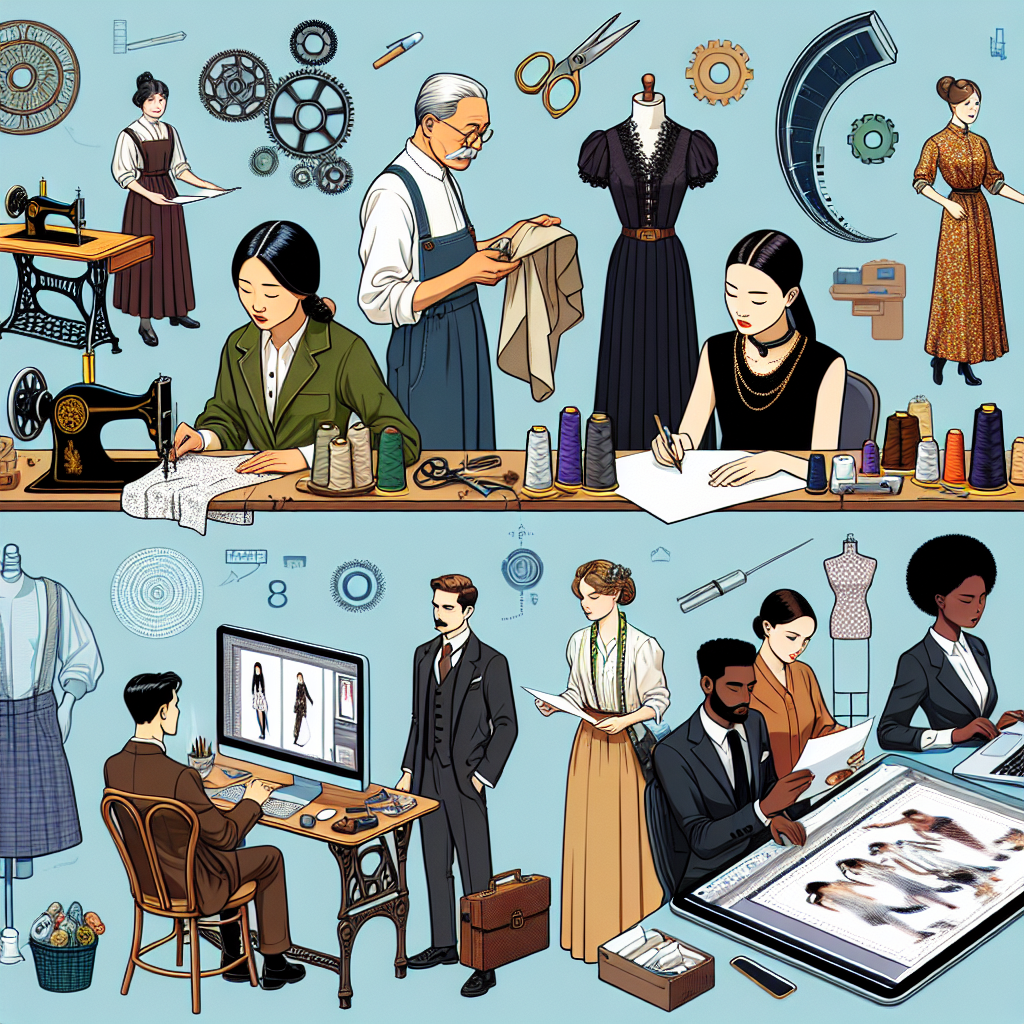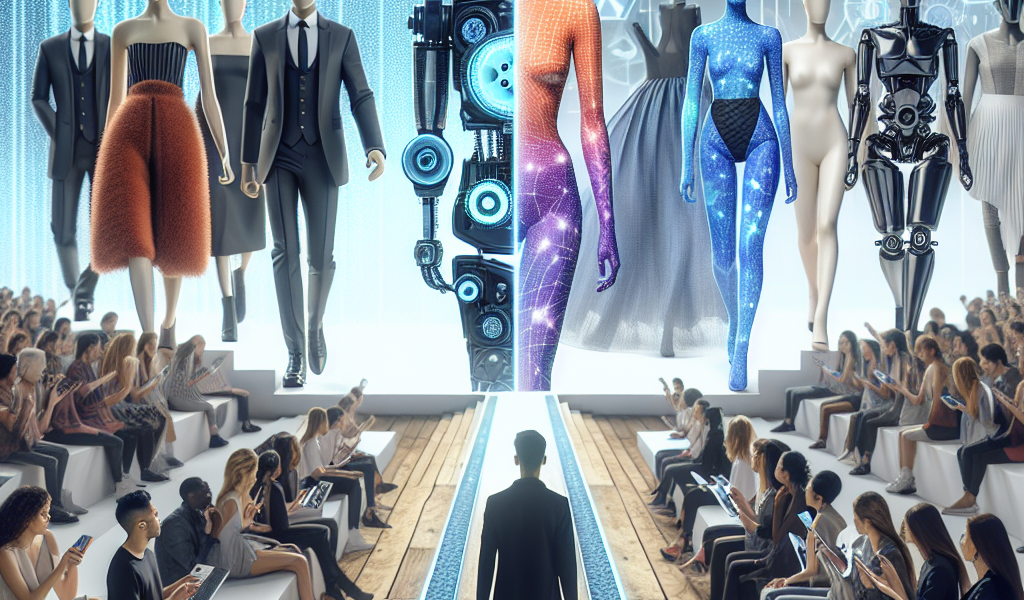-
Table of Contents
“Revolutionizing Style: The Digital Transformation of Fashion”
Introduction

The Impact of Technology on the Fashion Industry
The fashion industry, a dynamic and ever-evolving sector, has been profoundly transformed by the advent of technology. From the way designers conceptualize and create garments to how consumers shop and interact with brands, technological advancements have revolutionized every facet of the fashion world. Innovations such as 3D printing, artificial intelligence, and augmented reality have not only streamlined production processes but also enhanced the consumer experience, making fashion more accessible, personalized, and sustainable. This intersection of fashion and technology has paved the way for a new era of creativity, efficiency, and inclusivity, reshaping the industry’s landscape and setting the stage for future developments.
The Rise of Virtual Fashion Shows: How Technology is Revolutionizing Runway Events
The fashion industry, long known for its glitz and glamour, has always been a realm of innovation and creativity. However, in recent years, technology has begun to play an increasingly pivotal role in transforming how fashion is presented and consumed. One of the most striking examples of this transformation is the rise of virtual fashion shows, which have revolutionized runway events in ways that were once unimaginable.
Traditionally, fashion shows have been exclusive events, accessible only to a select few. Designers would showcase their latest collections to an audience of celebrities, industry insiders, and journalists, all gathered in a single, often opulent, location. However, the advent of virtual fashion shows has democratized this experience, making it accessible to a global audience. Through live streaming and virtual reality, anyone with an internet connection can now witness the latest trends and designs from the comfort of their own home. This shift has not only expanded the reach of fashion shows but has also allowed designers to engage with a more diverse and inclusive audience.
Moreover, the use of technology in virtual fashion shows has opened up new avenues for creativity and innovation. Designers are no longer constrained by the physical limitations of a traditional runway. Instead, they can experiment with digital environments, creating immersive experiences that blend fashion with art and technology. For instance, some designers have used augmented reality to superimpose their creations onto real-world settings, while others have created entirely virtual worlds where their designs can come to life in ways that would be impossible in a physical space. This fusion of fashion and technology has resulted in some truly breathtaking and memorable shows that push the boundaries of what is possible.
In addition to enhancing the visual and experiential aspects of fashion shows, technology has also streamlined the logistics and production processes. Virtual fashion shows eliminate the need for extensive travel, reducing the carbon footprint associated with traditional runway events. This shift towards sustainability is particularly important in an industry that has often been criticized for its environmental impact. Furthermore, digital platforms allow for real-time feedback and interaction, enabling designers to gauge audience reactions and make adjustments on the fly. This level of immediacy and responsiveness is unprecedented and has the potential to reshape the way fashion collections are developed and presented.
Another significant advantage of virtual fashion shows is their ability to provide a more inclusive platform for emerging designers. In the past, breaking into the fashion industry often required significant financial resources and connections. However, digital platforms have leveled the playing field, allowing up-and-coming designers to showcase their work to a global audience without the need for expensive runway shows. This democratization of fashion has led to a more diverse and vibrant industry, where talent and creativity are the primary drivers of success.
While the rise of virtual fashion shows has undoubtedly brought about many positive changes, it is important to acknowledge the challenges that come with this technological shift. The tactile experience of seeing and feeling garments in person is difficult to replicate in a virtual setting. Additionally, the social aspect of fashion shows, where industry professionals network and collaborate, is harder to achieve in a digital environment. Nevertheless, as technology continues to evolve, it is likely that these challenges will be addressed, further enhancing the virtual fashion show experience.
In conclusion, the rise of virtual fashion shows represents a significant and exciting development in the fashion industry. By leveraging technology, designers can reach a wider audience, experiment with new creative possibilities, and streamline their production processes. While there are challenges to overcome, the potential benefits of virtual fashion shows are immense, promising a future where fashion is more accessible, innovative, and sustainable than ever before.
Sustainable Fashion: The Role of Technology in Reducing Waste and Promoting Eco-Friendly Practices
In recent years, the fashion industry has undergone a significant transformation, driven largely by the integration of advanced technologies. This shift is not only revolutionizing how clothes are designed, produced, and marketed but also playing a crucial role in promoting sustainable practices. As the world grapples with the pressing issue of environmental degradation, the fashion sector is increasingly turning to technology to reduce waste and champion eco-friendly initiatives.
One of the most notable advancements in this realm is the advent of 3D printing. This technology allows designers to create intricate patterns and prototypes without the need for traditional materials, thereby significantly cutting down on fabric waste. By enabling precise production, 3D printing ensures that only the necessary amount of material is used, which is a stark contrast to conventional methods that often result in substantial offcuts and scraps. Moreover, this technology facilitates on-demand production, reducing the need for large inventories and minimizing the risk of unsold stock ending up in landfills.
In addition to 3D printing, digital fashion design tools are making waves in the industry. These tools allow designers to visualize and modify their creations in a virtual environment before committing to physical production. This not only speeds up the design process but also reduces the likelihood of errors and the need for multiple samples. Consequently, the environmental footprint of the design phase is significantly diminished. Furthermore, digital fashion shows and virtual try-ons are becoming increasingly popular, offering a sustainable alternative to traditional runway shows and in-store fittings, which often involve significant resource consumption and waste.
Another technological innovation that is making a substantial impact is the use of blockchain for supply chain transparency. By leveraging blockchain technology, fashion brands can provide consumers with detailed information about the origins and journey of their products. This transparency fosters trust and encourages consumers to make more informed, sustainable choices. Additionally, it holds brands accountable for their environmental and ethical practices, pushing them to adopt more sustainable methods.
The rise of smart textiles is also contributing to the sustainability movement within the fashion industry. These innovative fabrics are designed to be more durable and versatile, reducing the need for frequent replacements. Some smart textiles are even capable of self-repairing minor damages, further extending the lifespan of garments. Additionally, advancements in recycling technologies are enabling the creation of high-quality fabrics from post-consumer waste, such as plastic bottles and old clothing. This not only diverts waste from landfills but also reduces the demand for virgin materials, which are often resource-intensive to produce.
Moreover, the proliferation of e-commerce platforms and digital marketing strategies is reshaping consumer behavior. Online platforms provide a space for sustainable brands to reach a wider audience and educate consumers about the importance of eco-friendly fashion. Social media campaigns and influencer partnerships are also playing a pivotal role in raising awareness and driving the demand for sustainable products. As consumers become more conscious of their environmental impact, they are increasingly seeking out brands that align with their values, prompting the industry to prioritize sustainability.
In conclusion, technology is proving to be a powerful ally in the quest for a more sustainable fashion industry. From reducing waste through innovative production methods to promoting transparency and encouraging responsible consumer behavior, technological advancements are paving the way for a greener future. As the industry continues to evolve, it is clear that the integration of technology will be instrumental in driving sustainable practices and reducing the environmental footprint of fashion.
The Influence of Artificial Intelligence on Fashion Design and Personalization
The fashion industry, long celebrated for its creativity and innovation, is experiencing a transformative shift thanks to the integration of artificial intelligence (AI). This technological advancement is not only revolutionizing the way designers create but also how consumers experience fashion. As AI continues to evolve, its influence on fashion design and personalization becomes increasingly profound, offering a glimpse into a future where technology and style are seamlessly intertwined.
One of the most significant impacts of AI on fashion design is its ability to analyze vast amounts of data quickly and accurately. Designers can now leverage AI algorithms to predict trends, understand consumer preferences, and even generate new design concepts. By analyzing social media posts, online searches, and purchasing patterns, AI can identify emerging trends before they hit the mainstream. This predictive capability allows designers to stay ahead of the curve, creating collections that resonate with consumers’ evolving tastes.
Moreover, AI-powered tools are enhancing the creative process itself. For instance, generative design algorithms can produce a multitude of design variations based on a set of parameters defined by the designer. This not only speeds up the design process but also opens up new avenues for creativity. Designers can experiment with different styles, patterns, and materials in a virtual environment, making it easier to visualize and refine their ideas before committing to physical prototypes. This fusion of human creativity and machine efficiency is pushing the boundaries of what is possible in fashion design.
In addition to transforming the design process, AI is also revolutionizing the way consumers interact with fashion. Personalization has become a key focus, as brands strive to offer unique and tailored experiences to their customers. AI-driven recommendation systems analyze individual preferences and behaviors to suggest products that align with a consumer’s style. This level of personalization extends beyond simple product recommendations; it encompasses the entire shopping experience, from customized marketing messages to personalized virtual fitting rooms.
Virtual fitting rooms, powered by AI and augmented reality (AR), are changing the way consumers shop for clothes online. These innovative tools allow shoppers to see how garments will look and fit on their bodies without ever stepping into a physical store. By using AI to analyze body measurements and preferences, virtual fitting rooms provide a more accurate and satisfying shopping experience. This not only reduces the likelihood of returns but also enhances customer satisfaction, as shoppers can make more informed purchasing decisions.
Furthermore, AI is playing a crucial role in sustainability efforts within the fashion industry. By optimizing supply chain management and reducing waste, AI helps brands minimize their environmental impact. Predictive analytics can forecast demand more accurately, ensuring that production aligns with consumer needs and reducing excess inventory. Additionally, AI can assist in the development of sustainable materials and processes, further contributing to the industry’s shift towards eco-friendly practices.
As AI continues to advance, its influence on fashion design and personalization will only grow stronger. The integration of AI into the fashion industry is not just a trend; it is a fundamental shift that is reshaping the way we create, experience, and consume fashion. By harnessing the power of AI, designers can push the boundaries of creativity, brands can offer more personalized experiences, and the industry as a whole can move towards a more sustainable future. The marriage of technology and fashion is proving to be a harmonious one, promising exciting possibilities for both creators and consumers alike.
Conclusion
The impact of technology on the fashion industry has been profound and multifaceted, revolutionizing design, production, marketing, and retail. Advanced technologies such as 3D printing, AI, and augmented reality have enabled designers to create innovative and customized products with greater efficiency. Digital platforms and social media have transformed marketing strategies, allowing brands to reach global audiences instantly and interactively. E-commerce and virtual fitting rooms have enhanced the shopping experience, making it more convenient and personalized for consumers. Overall, technology has driven significant advancements in sustainability, creativity, and consumer engagement within the fashion industry, shaping its future trajectory.





